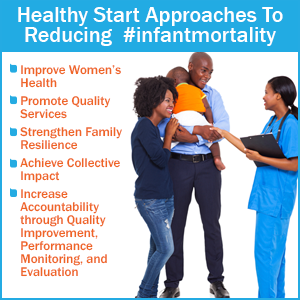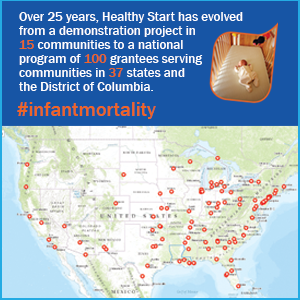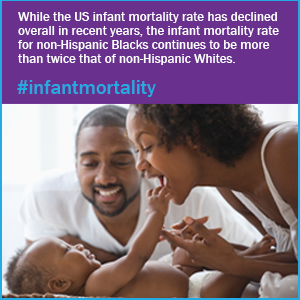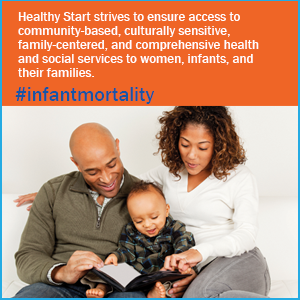Father/Partner Involvement Program evaluation Shared Measurement
Breastfeeding Case Management/Care Coordination Program evaluation Quality Improvement Social Determinants of Health
Father/Partner Involvement Participant Recruitment and Retention Quality Improvement
Common Agenda Father/Partner Involvement Participant Recruitment and Retention Socio-emotional Development for Children
Healthy Start projects across the country participate in the annual observance of September as Infant Mortality Awareness Month to raise awareness of Healthy Start’s role in addressing disparate infant mortality rates. Social media provides low cost ways to bring greater awareness to your Infant Mortality Awareness Month activities. This webinar is designed to showcase practical ways to use social media to promote your Healthy Start activities.
Following this webinar, participants will be able to:
- Understand how to be a part of the national social media presence for Infant Mortality Awareness Month.
- Add social media to their existing events.
- Understand how to submit events and photos to the HS EPIC Center for national promotion on social media.
Webinar Materials:
Communication
Medical‐legal partnership (MLP) is an approach to health that integrates the work of healthcare, public health, and civil legal aid to more effectively identify, treat, and prevent health‐harming legal needs for patients, clinics, and populations. MLP addresses legal needs in the areas of income supports and insurance; housing and utilities; employment and education; legal status; and personal and family stability. MLP:
- Trains healthcare, public health, and legal teams to work collaboratively and identify needs upstream;
- Treats individual patients’ health‐harming social and legal needs with legal care ranging from triage and consultations to legal representation;
- Transforms clinic practice and institutional policies to better respond to patients’ health‐harming social and legal needs; and
- Prevents health‐harming legal needs broadly by detecting patterns and improving policies and regulations that have an impact on population health.
Case Management/Care Coordination Insurance Coverage Other Risk Assessment
Beyond Access: Inequalities in the generation, manipulation, and distribution of health information and the capacity to act on health information among social and cultural groups in the United States is discussed in an audio presentation by Dr. Kasiomayajula Viswanath. He is an Associate Professor in the Department of Society, Human Development, and Health at the Harvard School of Public Health. His research focuses on how inequalities in communication are associated with health disparities.
Communication Community and Organizational Partnerships Cultural Competence Group Processes/Facilitation Health Equity Health Literacy Leadership Social Determinants of Health Strategic Planning
In this module, nationally recognized family leader and speaker, Ms. Eileen Forlenza addresses four critical strategies for increasing meaningful partnerships between Families and MCH Professionals. Anyone interested in issues around Children with Special Health Care Needs (CSHCN) will find this 30-minute leadership lesson incredibly insightful and helpful.
Learning Objectives:
- Professional Partnerships
- Create a shared vision
- Strengthen your foundation
- Explore innovation
- Demonstrate strong leadership
Community and Organizational Partnerships Group Processes/Facilitation
This course will cover the fundamental concepts of collaborative leadership and clarify the multiple layers of influence that impact health. Participants will receive an introduction to the knowledge and skills needed to effectively guide diverse groups of people to find solutions to complex problems that affect them all. Collaborative leadership is an evidence-based field that has proven particularly effective in public health planning where multiple stakeholders have an interest. Course topics include the nature of successful collaboration, characteristics of a collaborative leader and a discussion of the collaborative leadership practices. An overview of a multiple-sector approach to public health provides a context for the collaborative leadership discussions.
Learning Objectives:
- Determine when and when not to use collaboration 2. Compare five levels of relationships: networking, coordinating, cooperating, collaborating, and competing
- Identify three reasons people and organizations collaborate
- Identify some of the challenges to collaborative leadership
- Explain the context for collaboration
- Define the nature of successful collaboration
- Explain the meaning and nature of collaborative leadership
- Compare leadership styles
- Differentiate between “leadership” and “leader”
- Define the six practices of collaborative leadership Identify different ways to build collaborative leadership skills
Community and Organizational Partnerships Group Processes/Facilitation Leadership
This downloadable file is intended as an introduction to CBPR for people who are in the early stages of using or considering using CBPR.
Community and Organizational Partnerships




